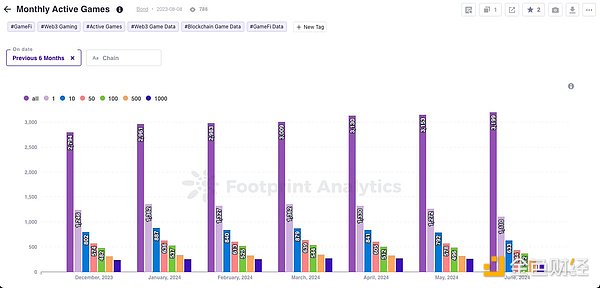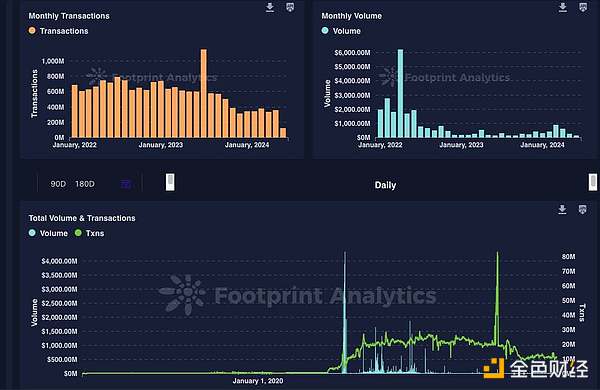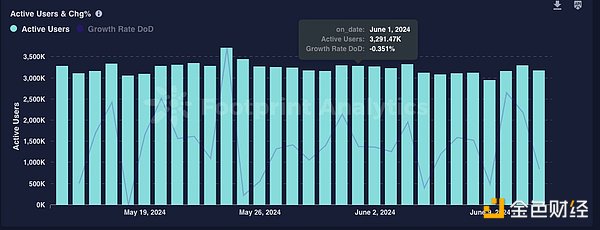Author: Footprint Analytics; Compiler: Shenchao TechFlow
Recently there have been some questions about whether blockchain games have What a great discussion, both sides have good points. Let’s analyze it from a data perspective.
Active games
As of May, the Footprint platform tracks 3,153 games, of which 263 games have more than 1,000 monthly active users (MAU), accounting for 8.2% of the total. If you raise the bar to 10,000 MAU, this number decreases significantly. It should be noted that these data only include on-chain users. Many games allow users to play without a wallet login while still containing Web3 elements. Currently, this part of the data is difficult to obtain and may affect the actual number of players.

Daily active users and transaction volume
May, Web3 The game’s daily active users (DAU) increased by 9.6% to 3.3 million users, but transaction volume dropped significantly compared to April (a decrease of US$390 million). DAU growth is a good sign, but this growth should also be accompanied by an increase in transaction volume. Transaction volume is an important indicator of whether a game is interesting enough to motivate players to spend money. Users play without contributing to the game, leaning more toward value extraction rather than input. The correlation between average user gaming time and transaction volume in May deserves further exploration.


The reason why new user growth is high but transaction volume is low
The "play the game to receive airdrops" mechanism implemented in recent games may be the main reason for this phenomenon. While the results are good in the short term, they can be detrimental to the project in the long term. Using incentives to attract user retention can help improve metrics, but without a solid gaming foundation, there may be a token sell-off after the airdrop ends, just like the single-token economic model, which can lead to an irrecoverable death spiral.
Retention rate
Retention rate is the best indicator of how interesting a game is one. In traditional Web2 games, the benchmarks for retention rates are: Day 1, 30-40%; Day 7, 20%; Day 30, 5-10%. In Web3, these retention benchmarks are harder to hit, but there are some games that do well with day 7 retention. Here are some examples of games with over 50,000 daily active users:
@ApeironNFT< /strong>: 86,987 DAU; Day 7 retention rate 79.3%
@StarryNift :73,146 DAU; Day 7 retention rate 70.8%
@pixels_online: 900,569 DAU; Day 7 retention rate 65.6%
@AxieInfinity: 63,385 DAU; Day 7 retention Rate 42.1%
@NineChronicles: 83,360 DAU; retention rate on day 7 is 40% (Note: Nine Chronicles has its own chain and is not indexed by Footprint)
Based on the retention data of the above games, it is believed that Web3 games are dead is incorrect. Without considering other metrics, it can even be inferred that Web3 games perform better than traditional benchmarks in terms of retention.
Currently restricting adoption issues
Speculation: The hype of potential profits obscures the real fun of the game.
User experience/interface: Currently, Web3 games have a lengthy registration process and the interface is complex and difficult to use. And not beautiful.
Time: Due to limited resources, games are often forced to be released before they are fully polished. Compared with traditional standards, Web3 games take longer to develop, and many excellent Web3 games have not yet been released.
Conclusion
At the current stage, It is both right and wrong to say that Web3 gaming is dead. Games have a short lifespan, and this is especially obvious in Web3, which can be seen from the comparison of active games and inactive games. Daily active users of Web3 have recently reached an all-time high, but are these users the users the industry expects? Retention rates, while high, are limited to a handful of games, and many lack enough daily active users to truly measure this metric. Ultimately, many of the problems that existed in the early days of Web3 gaming are still visible, but they will be fixed over time. In addition, mini-games like those on Telegram provide good examples of quickly and effectively onboarding new users into the game. Blockchain doesn’t need to revolutionize gaming, just improve it.
Web3 games are not dead, Web3 game construction is in progress...
 JinseFinance
JinseFinance
 JinseFinance
JinseFinance JinseFinance
JinseFinance JinseFinance
JinseFinance JinseFinance
JinseFinance JinseFinance
JinseFinance
 Bankless
Bankless Coindesk
Coindesk Bitcoinist
Bitcoinist Cointelegraph
Cointelegraph